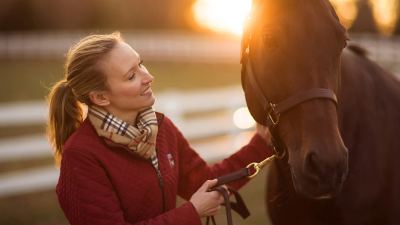How much hay to feed a horse in winter

Colder weather has begun to lay its annual claim on the land, and horses, especially those who live outdoors 24/7, are experiencing changing nutritional needs. Despite what many of us may think, and unlike their human counterparts, horses fare better in decreasing temperatures. In fact, our equine friends are most comfortable at temperatures between 18–59° Fahrenheit, depending on their winter coat, body condition and wind and/or moisture presence.
However, depending on the horse, the cold winter months may prescribe a need for dietary changes or supplementation not otherwise required in warmer weather. Hard keepers, senior horses and those with poor dentition, especially, can struggle to maintain a healthy body weight, while others may suffer from decreased thirst. All of these can equate to big problems for horse owners. Luckily, some seemingly minor nutritional changes can be beneficial for feeding horses in the winter, helping maintain weight, increase hydration and improve overall health.
Success starts with adequate roughage for horses
A mature horse at maintenance will consume 2–2.5% of their body weight in feed (both hay and grain) each day. At a minimum, horses must consume 1% of their body weight per day in good-quality forage to maintain a healthy gastrointestinal tract.
Some quick math will put this in a real-life perspective. The average 1,000-pound adult horse, on a day of normal weather conditions, will eat:
- Between 20–25 pounds of total feed
- A minimum of 10 pounds of hay/pasture (1.5–2% is preferred)
If you are feeding a diet that is solely forage, then you will need to estimate how much pasture your horse receives and how much additional hay you need to supply. Keep in mind that these ratios are likely to change in the winter when the ground is covered with snow, mud or other moisture, which is one reason why you may end up feeding more hay in the winter.
Additionally, increased energy will be spent to stay warm during the winter. Horses are better able to control body heat if suitable roughage is provided. The horse’s hindgut is a big fermentation center due to millions of bacteria, fungi and yeasts that reside there. As these good gut microbes ferment hay, they create heat as a side effect. This is just one reason why it is critical to promote gut health in horses.
Keep in mind that a horse’s need for heat (and therefore extra calories) will vary with the individual, depending on their:
- Age
- Breed
- Size
- Body condition
- Hair coat (has the horse been clipped?)
- Access to shelter
- Overall health status
- Geography and acclimation to cold weather
Observing your horse individually as the temperature drops is the best way to determine their needs. It is a good idea to consistently body condition score your horse throughout the winter and put your hands on the six key areas as winter coats can easily hide weight changes.
Also, remember: The horse has evolved over many centuries with much better systems (including a long winter coat) to keep warm than humans. Do not judge your horse’s circumstances or needs based on how you personally feel about the winter cold.
The lower critical temperature in horses
The lower critical temperature (LCT) is the temperature below which a horse requires additional energy to keep warm. In general, the estimated LCT is 41° Fahrenheit for horses with a summer coat and 18° Fahrenheit for horses with a winter coat.
The rule of thumb is that for each degree drop below the LCT, your horse requires a 1% increase in energy.
For example, if the temperature dropped to 0° Fahrenheit, a horse with a winter coat would require an 18% increase in feed. While some of this increase could come from grain concentrates, forage is the preferred source of increased energy due to its core-warming side effects that will help raise body temperature.
Improving water intake
The air temperature is not the only thing you need to consider. Drinking water should ideally fall between 45–65° Fahrenheit. If the water is too cold, intake will decrease, thereby reducing water and lubrication in the gut and, in turn, increasing the risk of cold-weather colic. As a reference, mature horses weighing 1,000 pounds require a minimum of 10–12 gallons of water daily to serve just their basic physiological needs.
To help encourage drinking in cold temperatures:
- Consider purchasing a water trough heater or de-icer to keep drinking water at preferred temperatures
- Add salt or an electrolyte mix to your horse’s diet. Electrolytes are not just for hot weather but are involved in thousands of body functions to keep your horse healthy throughout the year
Summary
In the wild, horses can move continuously, forage for food and water sources, and utilize thick, wooly coats and the warmth of the herd to survive in the winter months. Domesticated horses do not always have the same options. They are limited to the space, pasture mates and food we provide, and their hair coats often do not stand up to the elements, possibly requiring blanketing and/or appropriate shelter. It is our responsibility to ensure that their cold-weather needs are being adequately met to keep horses healthy and happy through every season.















